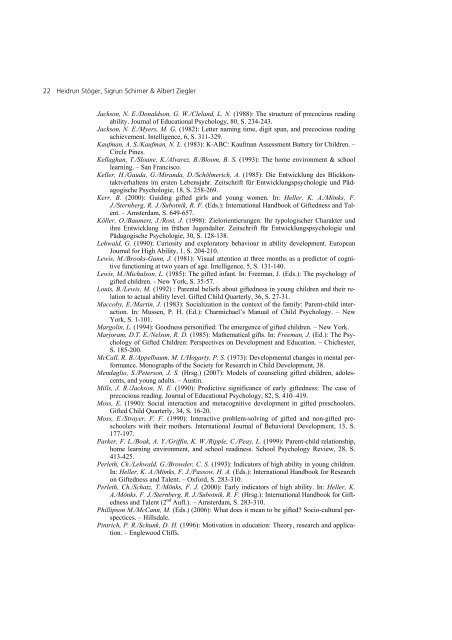Ist die Identifikation Begabter schon im Vorschulalter möglich? Ein ...
Ist die Identifikation Begabter schon im Vorschulalter möglich? Ein ...
Ist die Identifikation Begabter schon im Vorschulalter möglich? Ein ...
Sie wollen auch ein ePaper? Erhöhen Sie die Reichweite Ihrer Titel.
YUMPU macht aus Druck-PDFs automatisch weboptimierte ePaper, die Google liebt.
22 Heidrun Stöger, Sigrun Schirner & Albert Ziegler<br />
Jackson, N. E./Donaldson, G. W./Cleland, L. N. (1988): The structure of precocious reading<br />
ability. Journal of Educational Psychology, 80, S. 234-243.<br />
Jackson, N. E./Myers, M. G. (1982): Letter naming t<strong>im</strong>e, digit span, and precocious reading<br />
achievement. Intelligence, 6, S. 311-329.<br />
Kaufman, A. S./Kaufman, N. L. (1983): K-ABC: Kaufman Assessment Battery for Children. –<br />
Circle Pines.<br />
Kellaghan, T./Sloane, K./Alvarez, B./Bloom, B. S. (1993): The home environment & school<br />
learning. – San Francisco.<br />
Keller, H./Gauda, G./Miranda, D./Schölmerich, A. (1985): Die Entwicklung des Blickkontaktverhaltens<br />
<strong>im</strong> ersten Lebensjahr. Zeitschrift für Entwicklungspsychologie und Pädagogische<br />
Psychologie, 18, S. 258-269.<br />
Kerr, B. (2000): Guiding gifted girls and young women. In: Heller, K. A./Mönks, F.<br />
J./Sternberg, R. J./Subotnik, R. F. (Eds.): International Handbook of Giftedness and Talent.<br />
– Amsterdam, S. 649-657.<br />
Köller, O./Baumert, J./Rost, J. (1998): Zielorientierungen: Ihr typologischer Charakter und<br />
ihre Entwicklung <strong>im</strong> frühen Jugendalter. Zeitschrift für Entwicklungspsychologie und<br />
Pädagogische Psychologie, 30, S. 128-138.<br />
Lehwald, G. (1990): Curiosity and exploratory behaviour in ability development. European<br />
Journal for High Ability, 1, S. 204-210.<br />
Lewis, M./Brooks-Gunn, J. (1981): Visual attention at three months as a predictor of cognitive<br />
functioning at two years of age. Intelligence, 5, S. 131-140.<br />
Lewis, M./Michalson, L. (1985): The gifted infant. In: Freeman, J. (Eds.): The psychology of<br />
gifted children. - New York, S. 35-57.<br />
Louis, B./Lewis, M. (1992) : Parental beliefs about giftedness in young children and their relation<br />
to actual ability level. Gifted Child Quarterly, 36, S. 27-31.<br />
Maccoby, E./Martin, J. (1983): Socialization in the context of the family: Parent-child interaction.<br />
In: Mussen, P. H. (Ed.): Charmichael’s Manual of Child Psychology. – New<br />
York, S. 1-101.<br />
Margolin, L. (1994): Goodness personified: The emergence of gifted children. – New York.<br />
Marjoram, D.T. E./Nelson, R. D. (1985): Mathematical gifts. In: Freeman, J. (Ed.): The Psychology<br />
of Gifted Children: Perspectives on Development and Education. – Chichester,<br />
S. 185-200.<br />
McCall, R. B./Appelbaum, M. I./Hogarty, P. S. (1973): Developmental changes in mental performance.<br />
Monographs of the Society for Research in Child Development, 38.<br />
Mendaglio, S./Peterson, J. S. (Hrsg.) (2007): Models of counseling gifted children, adolescents,<br />
and young adults. – Austin.<br />
Mills, J. R./Jackson, N. E. (1990): Predictive significance of early giftedness: The case of<br />
precocious reading. Journal of Educational Psychology, 82, S. 410–419.<br />
Moss, E. (1990): Social interaction and metacognitive development in gifted preschoolers.<br />
Gifted Child Quarterly, 34, S. 16-20.<br />
Moss, E./Strayer, F. F. (1990): Interactive problem-solving of gifted and non-gifted preschoolers<br />
with their mothers. International Journal of Behavioral Development, 13, S.<br />
177-197.<br />
Parker, F. L./Boak, A. Y./Griffin, K. W./Ripple, C./Peay, L. (1999): Parent-child relationship,<br />
home learning environment, and school readiness. School Psychology Review, 28, S.<br />
413-425.<br />
Perleth, Ch./Lehwald, G./Browder, C. S. (1993): Indicators of high ability in young children.<br />
In: Heller, K. A./Mönks, F. J./Passow, H. A. (Eds.): International Handbook for Research<br />
on Giftedness and Talent. – Oxford, S. 283-310.<br />
Perleth, Ch./Schatz, T./Mönks, F. J. (2000): Early indicators of high ability. In: Heller, K.<br />
A./Mönks, F. J./Sternberg, R. J./Subotnik, R. F. (Hrsg.): International Handbook for Giftedness<br />
and Talent (2 nd Aufl.). – Amsterdam, S. 283-310.<br />
Phillipson M./McCann, M. (Eds.) (2006): What does it mean to be gifted? Socio-cultural perspectices.<br />
– Hillsdale.<br />
Pintrich, P. R./Schunk, D. H. (1996): Motivation in education: Theory, research and application.<br />
– Englewood Cliffs.


